When you buy through our links, we may earn an affiliate commission.
When it comes to the best bass guitar strings, there is no shortage of great options, regardless of the type of bass you play. But with so many choices, it can be difficult to sift through the field and find the type of strings that are the best fit for your sound and style.
In this guide, we’ll go over some of the best bass strings and the different features of bass strings so that you can make an informed buying decision to find the type of strings that is best for you.
Our top pick is the Ernie Ball Regular Slinky strings. The entire Slinky line is great, and the Regulars are a great combination of tight low-end, focused midrange, longevity, and affordability.
So no matter if you play electric bass, upright, or acoustic, these are our top picks for buying bass guitar strings.
Quick Summary of the Best Bass Strings
- Ernie Ball Regular Slinky Bass Strings (Best Bass Strings Overall)
- Rotosound RS66LD (Best Round Wound Bass Strings)
- La Bella 760FS (Best Flatwound Bass Strings)
- D’Addario ENR72 (Best Semi-flatwound Bass Strings)
- La Bella 750T Deep Talkin’ White Nylon (Best Tape Wound Bass Strings)
- Rotosound NXB45 Nexus (Best Coated Bass Strings)
- D'Addario HH610 3/4M Helicore Pizzicato Hybrid Double Bass String Set (Best Upright Bass Strings)
- Elixir 14502 Nanoweb (Best Acoustic Bass Strings)
Best Bass Strings
1. Best Bass Strings Overall – Ernie Ball Regular Slinky Bass Strings

SPECS
- Winding Type: Roundwound
- Core/Winding Material: Steel / nickel-plated steel
- Scale Length: Long
The Ernie Ball Slinky series is one of the most popular brands when it comes to bass strings. Overall, the Slinky line is one of the best choices for electric bass guitars.
Slinky strings come in multiple string gauges and at a bass string gauge range of .45-.105, Regular Slinkys are perfect for bass players who use a four-string bass. But they do offer variations for different types of basses.
Bass strings are also more expensive (sometimes a lot) than guitar strings, but the trade-off is you generally change them much less frequently.
Ernie Ball Slinkys have a good lifespan, too, especially if you keep them clean and wipe them down after a playing session.
Ernie Ball’s Slinky line is a great combination of sound, affordability, quality, and longevity, and any bass player should at least give Slinkys a shot.
2. Best Round Wound Bass Strings – Rotosound RS66LD
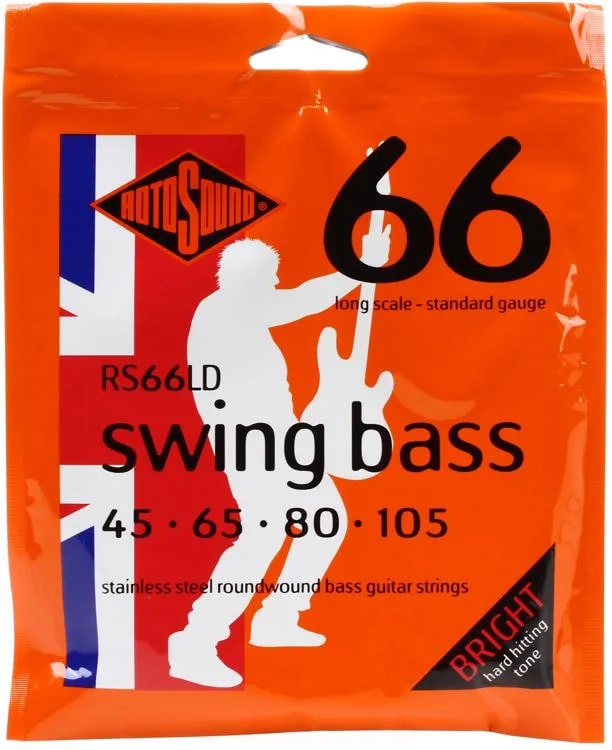
SPECS
- Winding Type: Round wound
- Core/Winding Material: Steel / stainless steel
- Scale Length: 32-34”, Long
One of the first manufacturers to start producing round wound strings with a stainless steel wrap was Rotosound. They were a game changer when they came out in 1962 and immediately caught on with low-end legends like John Paul Jones of Led Zeppelin and Geddy Lee of Rush.
But it wasn’t just rock bass players that adopted Rotosound strings. Jazz legend Jaco Pastorius is listed as a user, and the overall artist roster is impressive.
Round wound strings are generally what comes to mind when you imagine “standard” bass strings. This means that the wrapping wire has tangible “ridges.”
Round wound strings are usually the type of string that ship with a bass. They have a good frequency balance and offer a brighter sound that cuts without sacrificing any weight in the low end.
Rotosound offers a number of different gauges and scales, but these are standard long scale at a gauge set of .45-.105. They’re great for any genre and are packaged in sealed foil to ensure maximum freshness when you open them up.
3. Best Flatwound Bass Strings – La Bella 760FS
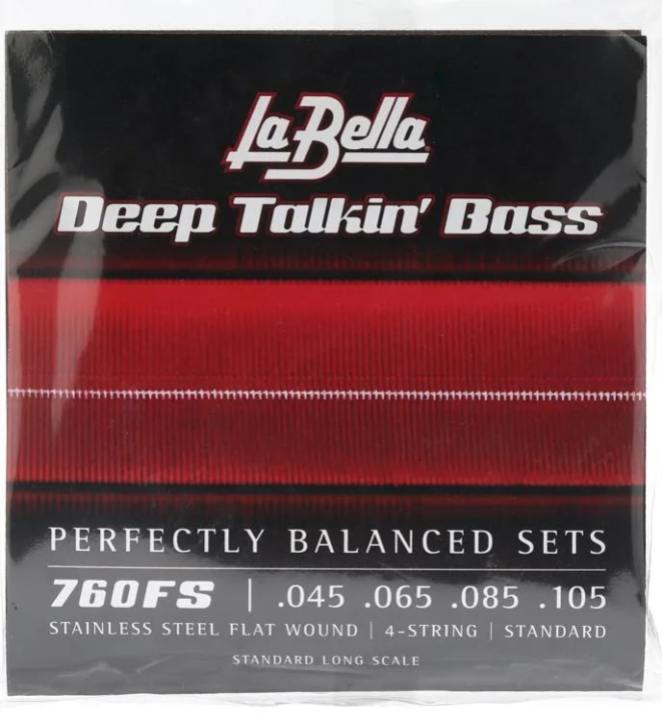
SPECS
- Winding Type: Flatwound
- Core/Winding Material: Steel / stainless steel
- Scale Length: 36.75-38”, Long
La Bella is a manufacturer that flies a little bit under the radar but make no mistake - their bass strings are top quality. With the company starting in the 1950s, they’re well-known as one of the premier bass string manufacturers for a reason.
Converse to round wound strings, flatwound strings have a “flat” feel. They feel smoother without the identifiable ridges that round wound strings have. These strings are made with a flat, hand-polished winding for smooth action that makes it easy to travel up and down the fretboard.
When it comes to their sonic character, they provide deep low end with a good harmonic structure and amount of sustain. They’re built to keep their punchy sound after other strings would have long been dead.
And they work on fretted and fretless basses. To prevent premature aging and oxidation, they are shipped in MAP (modified atmosphere packaging).
Compared to other string manufacturers, the 760FS line costs almost twice as much as strings from companies like Ernie Ball and Rotosound. Keep in mind they’re only designed to work with top-loading bridges and won’t work for string-through body basses.
The company has a storied history that goes back centuries, and it shows in the quality of their products.
4. Best Semi-flatwound Bass Strings – D’Addario ENR72
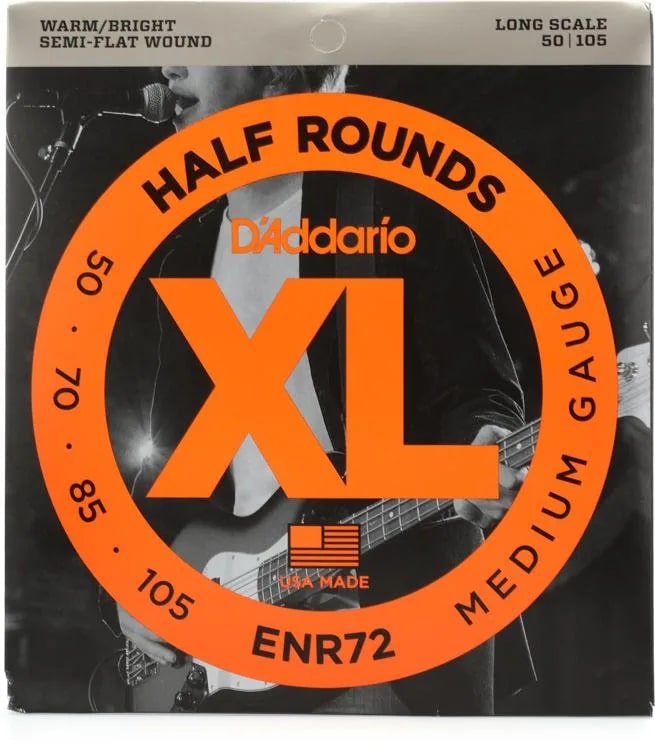
SPECS
- Winding Type: Half round
- Core/Winding Material: Steel / pure nickel
- Scale Length: Long
Semi-flat wound bass strings are just that, a combination of flat wound and round wound string design. This gives them a good mix of the smooth feel and string travel of flat wounds with the versatility of round wound strings.
D’Addario’s ENR72 string set offers a lot of sustain and a comfortable feel with a cutting and bright tone.
The metal combination of a steel core with pure nickel winding helps them stand up to the lifespan that modern bass players have come to expect.
Like La Bella, D’Addario is another company with a history that goes back for centuries. There’s a reason they’re one of the most popular string manufacturers for bass players and guitarists.
The ENR72 string set offers a great combination of punch and clarity while keeping the feel easy on your fingers.
5. Best Tape Wound Bass Strings – La Bella 750T Deep Talkin’ White Nylon

SPECS
- Winding Type: Tape
- Core/Winding Material: Steel / white nylon tape over stainless steel
- Scale Length: 36.75-38”, Long
Tape wound bass strings are less popular than round wounds or flat wounds, but they offer a unique feel and sound that makes them worth looking into if you’re looking to experiment with your sound.
They’re made with a steel core wrapped with a white nylon tape winding. This provides a unique glide that works well with fretted and fretless electric basses just as much as acoustic basses.
The 750T strings are a long scale, with excellent harmonics in the high mid frequencies. And their versatility gives them their own distinct advantage over other types of string makes. They’re a little pricier than some of the alternatives, though.
Tapewound strings might take some getting used to at first, but they offer a feel and sound all their own. A lot of bass players refer to the feel as “silky” and easier on their fingers than other string types.
6. Best Coated Bass Strings – Rotosound NXB45 Nexus
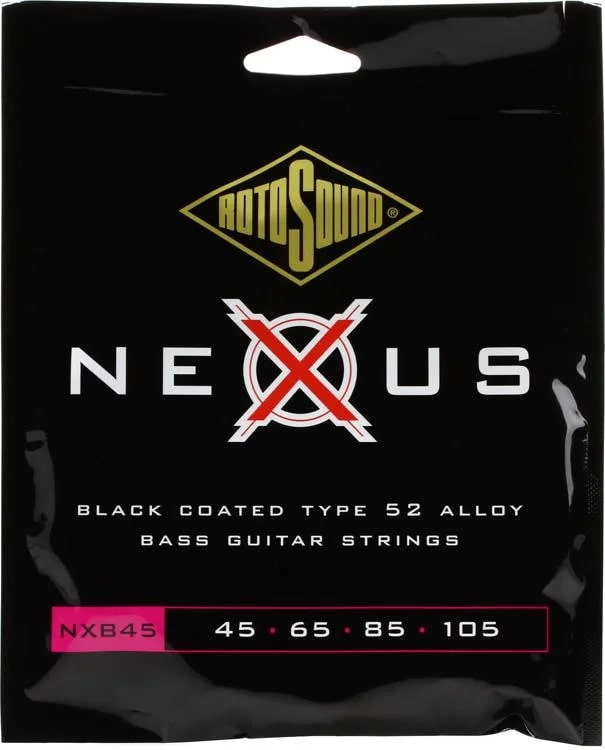
SPECS
- Winding Type: Roundwound
- Core/Winding Material: Steel / type 52 alloy
- Scale Length: 32-34”, Long
Coated strings are tailor-made for providing a great string life that doesn’t oxidize as fast as uncoated strings. They use a small layer of coating between the wrap wire and the player’s fingers.
This means that dirt and rust don’t accumulate as quickly. So you get a longer string life out of them and don’t have to invest in strings as often. Coated strings also don’t have as much “finger squeak” as uncoated strings, but this also gives them a more slippery feel.
Rotosound’s Nexus coated strings have a solid richness in the midrange, and the top end provides a nice cut through the mix. The interior string wrap is a unique Type 52 alloy with a roundwound exterior.
Coated strings are a debated topic in the guitar world. Some players think they’re easier to play because the coating makes them feel more comfortable and provides better finger glide. Other players think they have a duller sound because the string resonates differently.
7. Best Upright Bass Strings – D'Addario HH610 3/4M Helicore Pizzicato Hybrid Double Bass String Set

SPECS
- Winding Type: N/A
- Core/Winding Material: Multi-strand steel
- Scale Length: ¾ scale, Medium tension
The HH610 double bass string set starts with a multi-strand steel core. This type of core provides the response, articulation, and warmth you want in upright bass strings.
Due to how balanced the response is, they’re great for playing with a bow or playing pizzicato. They have great stability in pitch, which is a critical factor in any type of string. Especially double bass strings. They’re a ¾ size that provides medium tension.
Upright bass strings are definitely not cheap, but there is also an increased cost in the manufacturing process over electric bass guitar strings. But due to the way they accommodate two playing styles, they’re a good investment.
8. Best Acoustic Bass Strings – Elixir 14502 Nanoweb
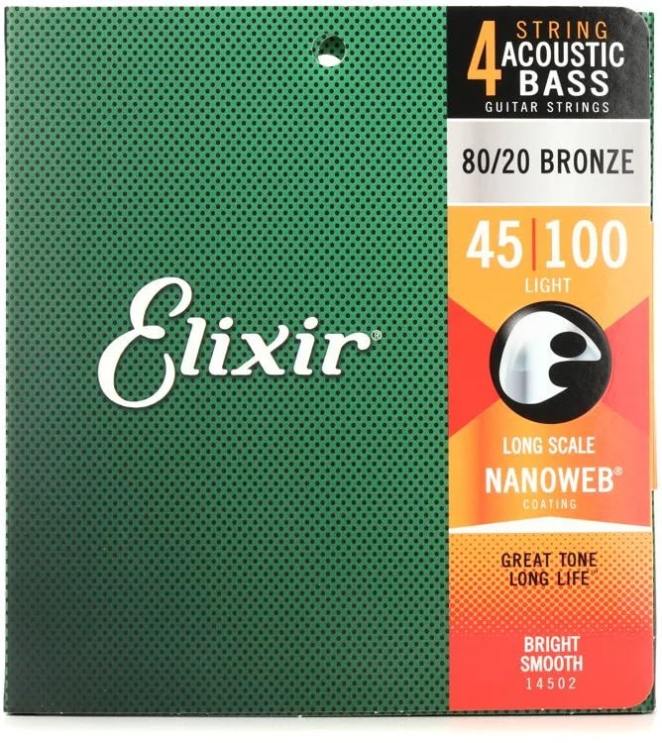
SPECS
- Winding Type: Round wound
- Core/Winding Material: Steel / 80/20 bronze
- Scale Length: Long
Acoustic bass is a unique and tonally complex instrument, so you need a good set of strings to match. And Elixir makes some of the best in the Nanoweb 14502 model.
At a .45-.100 gauge range they’re a little easier on the fingers. They’re made of an 80/20 bronze string copper/zinc alloy. This gives a full tone that works for different musical styles. Elixir’s Nanoweb coating gives a good glide and soft feel.
This type of material makeup sounds great with acoustic bass guitars that are made of various tonewoods, adding to their appeal.
The 14502 set has a good tonal signature with just the right amount of brightness to fit into the mix. They’re a little pricier than other string sets but still affordable enough that make them worth a look.
Best Bass Strings Buyer's Guide
Just like when you’re trying out guitar strings, you have a few things to take into consideration when picking the best bass strings for you.
The type of winding is one of the biggest factors, as it translates into how the strings sound and how comfortable they are to play. These are some of the most important things to factor in when you’re experimenting with different types of bass strings.
Winding Type
The type of winding is one of the biggest factors when it comes to choosing the best bass strings for you. Bass strings come in four main winding types: round wound, flat wound, half round, and tape wound.
Round wound strings are one of the most popular. This means there is a metal winding around the core. These are a very common type of string, one of the most popular - especially in the rock music world.
The ridges are much more noticeable to the touch, and round wound strings are usually the string type that comes stock when you buy a bass. They’re brighter than flat wounds and are great for playing with a pick or fingers, and evenly balanced across the bass guitar frequency spectrum.
Flat wound strings have a flat wrapping wire. This means you can hardly sense the ridges of the wrapping. Due to this design, you can use them with a lower action setup. With flat wound strings, the feel isn’t as stiff.
The high-frequency threshold is lower with flat wounds and puts more emphasis on the low end and midrange. They usually have a darker overall sound, but some players feel they provide easier playability. And less wear and tear on the fretboard and frets overall.
A third type is called half wound strings. They still have an outer winding, but it falls between round wound and flat wound. Half wound strings offer a warm tone with a smooth feel.
The fourth and final type of wound bass strings are tapewound. Tapewound strings have an outer wrapping made from nylon. These type of strings have a shorter decay and more “thump” to the sound.
All types of windings have their benefits and drawbacks, so it’s best to experiment to find the type that fits the tone and feel you’re chasing.
Core and Winding Material
The type of metal(s) used in the core and winding composition of bass strings factors into how they sound.
A number of different metals and alloys are used. The two main types of winding metals are nickel/steel alloy and stainless steel. Strings that use nickel/steel have a softer sound than strings that are made from pure steel, and steel strings generally have a brighter attack and offer more volume.
Nickel/steel strings are great for beginners at bass guitar, as they’re easier on the hands until you build up strength and callouses.
Scale Length
The scale of a bass is the distance from the bridge to the nut. This affects the length of vibration of the strings. And like guitars, basses come in varying scale lengths. It’s not as big of a concern because you can always cut the strings to the proper length.
But if you’re using something like a short scale or ¾ scale bass, this is something to keep in mind. Long-scale basses are usually in the 34” range. Short-scale basses usually fall in the range of 30-32 inches.
Electric or Acoustic
This is pretty obvious, but bass strings for electric, acoustic, and upright basses are all different. You need to choose the type that fits the design of your bass guitar.
String Gauge
String gauge refers to how thick the string set is. Since each player has their own gauge preference, companies offer a range of options.
Some things to keep in mind when choosing string gauges are what kind of tension you like in the playing feel and the tuning standard you use. If you like more tension, heavy gauge strings might be best for you.
You also have to consider the tuning you’re using. For E standard, a lot of players prefer lighter gauge strings. But if you’re down tuning, even a half step to Eb standard, you might want to go with heavy gauge strings due to compensate for the slacker string tension of the tuning.
Strings for Fretless Bass
Fretless basses are just that, so the strings are closer to the fretboard. A lot of fretless bass players prefer flatwound strings because they’re believed to be better for the neck. This isn’t a hard and fast rule, but something to consider.
Frequently Asked Questions (FAQs)
What string is best for bass?
The best strings for bass depend on the type of bass you play, the sound you’re looking for, and how you want them to feel. Electric bass strings are different than upright and acoustic bass strings, just like with a guitar.
You also have to consider your playing style. The best strings for using a pick can differ from playing fingerstyle, especially if you have more of a slapping style popular with funk bass players.
What are the most versatile bass strings?
In general, round wound strings are the most versatile bass strings. They provide a balanced tone across the frequency spectrum that fits multiple styles.
What gauge strings do most bass players use?
Determining what type of gauge strings to use is up to player preference. A lot of bass players that use E standard tuning string their bass guitar with a set in the .45-.105 range. But there are some reasons why a player might choose to go with a thicker gauge.
Conclusion
Depending on the sound you want and the string feel you need; there are certain things to think about when choosing what type of bass strings to use. The type of bass you play, your particular playing style, and your genres of music all factor in.
We chose the Ernie Ball Regular Slinky string set as our overall favorite. They provide a tone that works with any style of music, they're easy to play, and have a great balance across the frequency spectrum.
But if you prefer flat wound strings over round wounds, our runner-up pick is the La Bella 760FS. They're pricey, but if you're serious about your sound, they make some of the best bass strings on the market.
The company has a storied history based on a tradition of the highest quality, and one of the best features is this string set works on fretted and fretless basses.
If you haven't settled on a style of string and are still looking for the best one for you, experimenting with different string styles is key. Eventually, you'll find the one that's the perfect fit.
